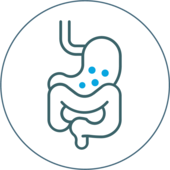MICROBIAL VOLUME AND DIVERSITY
THE GUT MICROBIOME IS COMPOSED OF HIGHLY DIVERSE MICROORGANISMS LIVING IN THE HUMAN INTESTINAL TRACT
Considered a distinct and essential organ within the human body, the gut microbiome contains 100 trillion microorganisms and consists of an estimated 500-1000 different species.1-4

Common bacterial phyla in the gut1,5:
- Bacteroidetes
- Firmicutes
- Proteobacteria
- Actinobacteria
- Fusobacteria
- Verrucomicrobia
Comprise ~90% of microbiota
References: 1. Thursby E, Juge N. Biochem J. 2017;474(11):1823-1836. 2. Gilbert JA, et al. Nat Med. 2018;24(4):392-400. 3. Antharam VC, et al. J Clin Microbiol. 2013;51(9):2884-2892. 4. Marchesi JR, et al. Gut. 2016;65(2):330-339. 5. Jandhyala SM, et al. World J Gastroenterol. 2015;21(29):8787-8803. 6. Wexler AG, Goodman AL. Nat Microbiol. 2017;2(1):17115. 7. Rinninella E, et al. Microorganisms. 2019;7(1):14. 8. Gill SR, et al. Science. 2006;312(5778):1355-1359. 9. Kurokawa K, et al. DNA Res. 2007;14(4):169-181. 10. Li X, et al. Biomed Pharmacother. 2021;137:111290. 11. Kho ZY, Lal SK. Front Microbiol. 2018;9(1835):1-23. 12. Sokol H, et al. Proc Natl Acad Sci USA. 2008;105(43):16731-16736. 13. Willing BP, et al. Gastroenterology. 2010;139(6):1844-1854.e1. 14. Machiels K, et al. Gut. 2014;63(8):1275-1283. 15. Paust S, et al. Proc Natl Acad Sci USA. 2004;101(28):10398-10403. 16. El Aidy S, et al. Mucosal Immunol. 2012;5(5):567-579. 17. Lawley TD, Walker AW. Immunology. 2013;138(1):1-11. 18. Herrera G, et al. Sci Rep. 2021;11(1):10849. 19. Theriot CM, Young VB. Annu Rev Microbiol. 2015;69:445-461.
MICROBIAL VOLUME AND DIVERSITY
BACTEROIDETES AND FIRMICUTES ARE MOST PREVALENT IN THE GUT
MICROBIOME AND WORK SYMBIOTICALLY6-8

Gram-negative Bacteroidetes
Their ability to adapt and persist in changing gut environments allows abundance and stability,6,9-11 providing long-term associations with human hosts and enabling functions that include6..
- Immunomodulatory effects6,a
- Inhibitory activities against C. difficile and reduction of colonization12,a,b

Gram-positive Firmicutes
Composed of helpful and harmful bacteria,3,13 Firmicutes are the most abundant and diverse bacterial gut species,3 with functions that include:
- Anti-inflammatory effects14-16,c
- Fortification of gut barrier (along with other bacteria)17-19,b
aSome Bacteroidetes. bIn preclinical studies. cDemonstrated in Crohn’s disease, inflammatory bowel disease, and ulcerative colitis studies.
Deficiencies in
Bacteroidetes and
Firmicutes are
particularly
associated with
C. difficile infection.3,8,20
References: 1. Thursby E, Juge N. Biochem J. 2017;474(11):1823-1836. 2. Gilbert JA, et al. Nat Med. 2018;24(4):392-400. 3. Antharam VC, et al. J Clin Microbiol. 2013;51(9):2884-2892. 4. Marchesi JR, et al. Gut. 2016;65(2):330-339. 5. Jandhyala SM, et al. World J Gastroenterol. 2015;21(29):8787-8803. 6. Wexler AG, Goodman AL. Nat Microbiol. 2017;2(1):17115. 7. Rinninella E, et al. Microorganisms. 2019;7(1):14. 8. Gill SR, et al. Science. 2006;312(5778):1355-1359. 9. Kurokawa K, et al. DNA Res. 2007;14(4):169-181. 10. Li X, et al. Biomed Pharmacother. 2021;137:111290. 11. Kho ZY, Lal SK. Front Microbiol. 2018;9(1835):1-23. 12. Sokol H, et al. Proc Natl Acad Sci USA. 2008;105(43):16731-16736. 13. Willing BP, et al. Gastroenterology. 2010;139(6):1844-1854.e1. 14. Machiels K, et al. Gut. 2014;63(8):1275-1283. 15. Paust S, et al. Proc Natl Acad Sci USA. 2004;101(28):10398-10403. 16. El Aidy S, et al. Mucosal Immunol. 2012;5(5):567-579. 17. Lawley TD, Walker AW. Immunology. 2013;138(1):1-11. 18. Herrera G, et al. Sci Rep. 2021;11(1):10849. 19. Theriot CM, Young VB. Annu Rev Microbiol. 2015;69:445-461.
MICROBIAL VOLUME AND DIVERSITY
THE BROAD CONSORTIUM OF BACTERIA WITHIN THE GUT MICROBIOME FUNCTIONS TO PROMOTE OVERALL HEALTH

Aids in health digestive function19

Protects from harmful microorganisms and plays a role in immunity19

Acts as a barrier and achieves colonization resistance1,19
References: 1. Thursby E, Juge N. Biochem J. 2017;474(11):1823-1836. 2. Gilbert JA, et al. Nat Med. 2018;24(4):392-400. 3. Antharam VC, et al. J Clin Microbiol. 2013;51(9):2884-2892. 4. Marchesi JR, et al. Gut. 2016;65(2):330-339. 5. Jandhyala SM, et al. World J Gastroenterol. 2015;21(29):8787-8803. 6. Wexler AG, Goodman AL. Nat Microbiol. 2017;2(1):17115. 7. Rinninella E, et al. Microorganisms. 2019;7(1):14. 8. Gill SR, et al. Science. 2006;312(5778):1355-1359. 9. Kurokawa K, et al. DNA Res. 2007;14(4):169-181. 10. Li X, et al. Biomed Pharmacother. 2021;137:111290. 11. Kho ZY, Lal SK. Front Microbiol. 2018;9(1835):1-23. 12. Sokol H, et al. Proc Natl Acad Sci USA. 2008;105(43):16731-16736. 13. Willing BP, et al. Gastroenterology. 2010;139(6):1844-1854.e1. 14. Machiels K, et al. Gut. 2014;63(8):1275-1283. 15. Paust S, et al. Proc Natl Acad Sci USA. 2004;101(28):10398-10403. 16. El Aidy S, et al. Mucosal Immunol. 2012;5(5):567-579. 17. Lawley TD, Walker AW. Immunology. 2013;138(1):1-11. 18. Herrera G, et al. Sci Rep. 2021;11(1):10849. 19. Theriot CM, Young VB. Annu Rev Microbiol. 2015;69:445-461.
